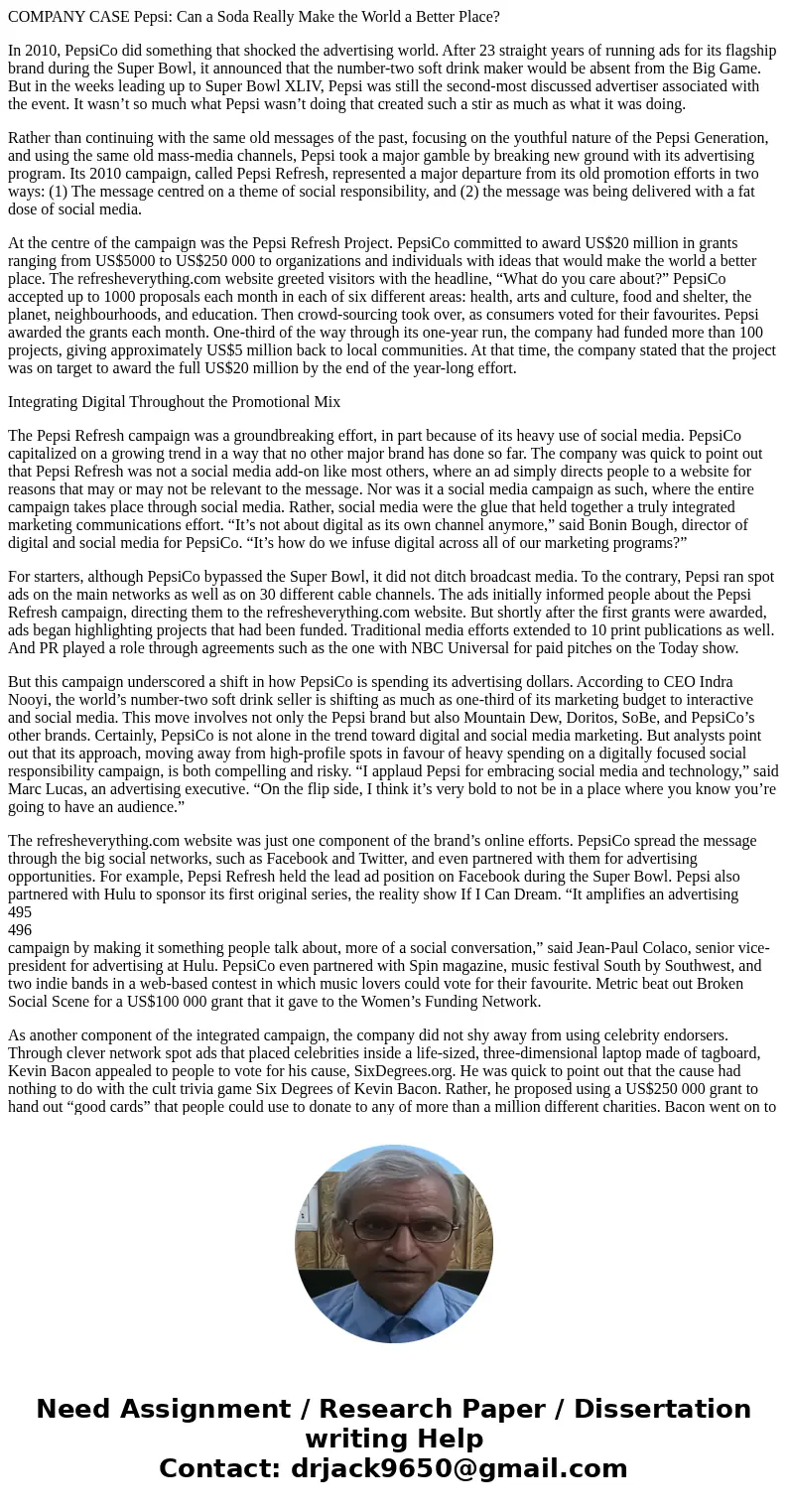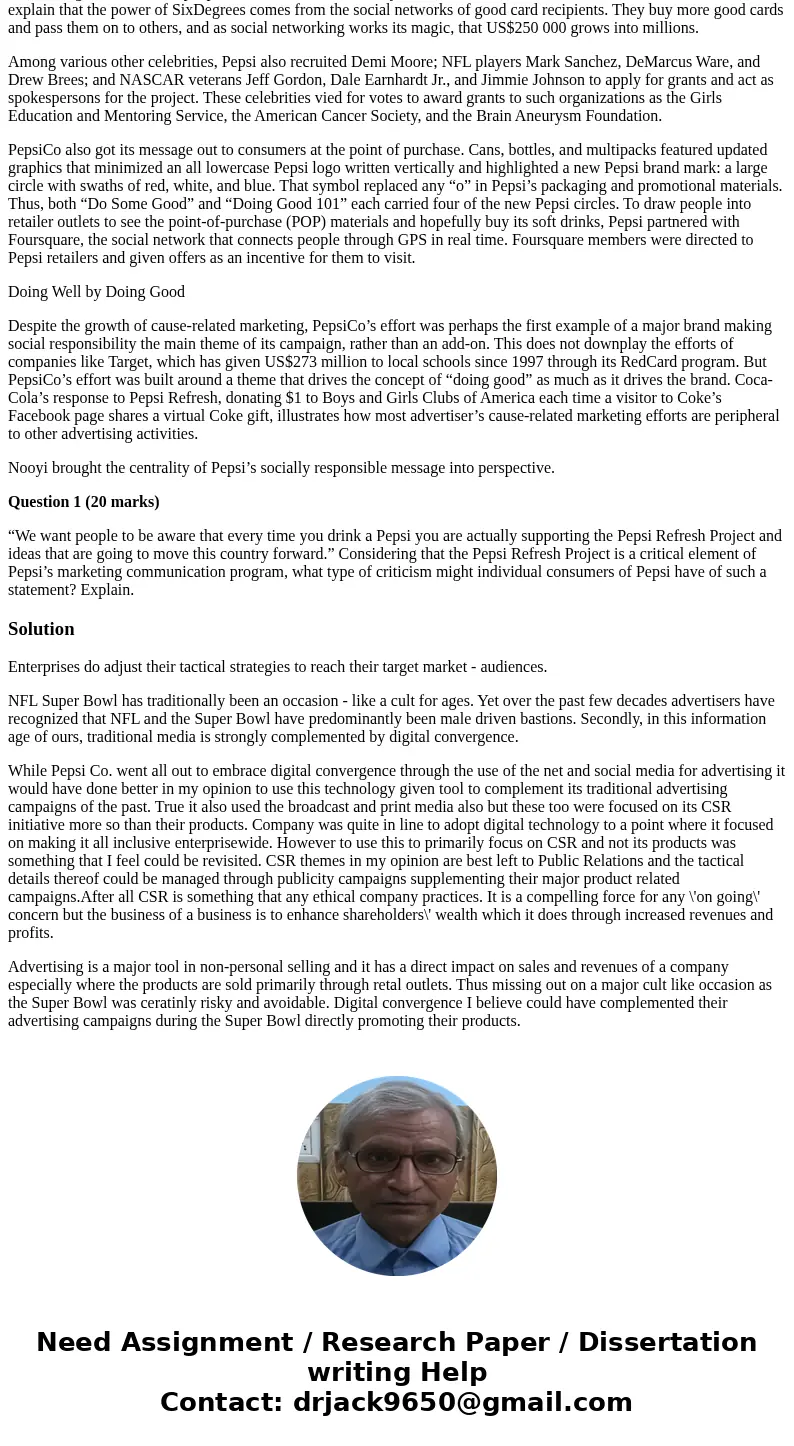COMPANY CASE Pepsi Can a Soda Really Make the World a Better
COMPANY CASE Pepsi: Can a Soda Really Make the World a Better Place?
In 2010, PepsiCo did something that shocked the advertising world. After 23 straight years of running ads for its flagship brand during the Super Bowl, it announced that the number-two soft drink maker would be absent from the Big Game. But in the weeks leading up to Super Bowl XLIV, Pepsi was still the second-most discussed advertiser associated with the event. It wasn’t so much what Pepsi wasn’t doing that created such a stir as much as what it was doing.
Rather than continuing with the same old messages of the past, focusing on the youthful nature of the Pepsi Generation, and using the same old mass-media channels, Pepsi took a major gamble by breaking new ground with its advertising program. Its 2010 campaign, called Pepsi Refresh, represented a major departure from its old promotion efforts in two ways: (1) The message centred on a theme of social responsibility, and (2) the message was being delivered with a fat dose of social media.
At the centre of the campaign was the Pepsi Refresh Project. PepsiCo committed to award US$20 million in grants ranging from US$5000 to US$250 000 to organizations and individuals with ideas that would make the world a better place. The refresheverything.com website greeted visitors with the headline, “What do you care about?” PepsiCo accepted up to 1000 proposals each month in each of six different areas: health, arts and culture, food and shelter, the planet, neighbourhoods, and education. Then crowd-sourcing took over, as consumers voted for their favourites. Pepsi awarded the grants each month. One-third of the way through its one-year run, the company had funded more than 100 projects, giving approximately US$5 million back to local communities. At that time, the company stated that the project was on target to award the full US$20 million by the end of the year-long effort.
Integrating Digital Throughout the Promotional Mix
The Pepsi Refresh campaign was a groundbreaking effort, in part because of its heavy use of social media. PepsiCo capitalized on a growing trend in a way that no other major brand has done so far. The company was quick to point out that Pepsi Refresh was not a social media add-on like most others, where an ad simply directs people to a website for reasons that may or may not be relevant to the message. Nor was it a social media campaign as such, where the entire campaign takes place through social media. Rather, social media were the glue that held together a truly integrated marketing communications effort. “It’s not about digital as its own channel anymore,” said Bonin Bough, director of digital and social media for PepsiCo. “It’s how do we infuse digital across all of our marketing programs?”
For starters, although PepsiCo bypassed the Super Bowl, it did not ditch broadcast media. To the contrary, Pepsi ran spot ads on the main networks as well as on 30 different cable channels. The ads initially informed people about the Pepsi Refresh campaign, directing them to the refresheverything.com website. But shortly after the first grants were awarded, ads began highlighting projects that had been funded. Traditional media efforts extended to 10 print publications as well. And PR played a role through agreements such as the one with NBC Universal for paid pitches on the Today show.
But this campaign underscored a shift in how PepsiCo is spending its advertising dollars. According to CEO Indra Nooyi, the world’s number-two soft drink seller is shifting as much as one-third of its marketing budget to interactive and social media. This move involves not only the Pepsi brand but also Mountain Dew, Doritos, SoBe, and PepsiCo’s other brands. Certainly, PepsiCo is not alone in the trend toward digital and social media marketing. But analysts point out that its approach, moving away from high-profile spots in favour of heavy spending on a digitally focused social responsibility campaign, is both compelling and risky. “I applaud Pepsi for embracing social media and technology,” said Marc Lucas, an advertising executive. “On the flip side, I think it’s very bold to not be in a place where you know you’re going to have an audience.”
The refresheverything.com website was just one component of the brand’s online efforts. PepsiCo spread the message through the big social networks, such as Facebook and Twitter, and even partnered with them for advertising opportunities. For example, Pepsi Refresh held the lead ad position on Facebook during the Super Bowl. Pepsi also partnered with Hulu to sponsor its first original series, the reality show If I Can Dream. “It amplifies an advertising
495
496
campaign by making it something people talk about, more of a social conversation,” said Jean-Paul Colaco, senior vice-president for advertising at Hulu. PepsiCo even partnered with Spin magazine, music festival South by Southwest, and two indie bands in a web-based contest in which music lovers could vote for their favourite. Metric beat out Broken Social Scene for a US$100 000 grant that it gave to the Women’s Funding Network.
As another component of the integrated campaign, the company did not shy away from using celebrity endorsers. Through clever network spot ads that placed celebrities inside a life-sized, three-dimensional laptop made of tagboard, Kevin Bacon appealed to people to vote for his cause, SixDegrees.org. He was quick to point out that the cause had nothing to do with the cult trivia game Six Degrees of Kevin Bacon. Rather, he proposed using a US$250 000 grant to hand out “good cards” that people could use to donate to any of more than a million different charities. Bacon went on to explain that the power of SixDegrees comes from the social networks of good card recipients. They buy more good cards and pass them on to others, and as social networking works its magic, that US$250 000 grows into millions.
Among various other celebrities, Pepsi also recruited Demi Moore; NFL players Mark Sanchez, DeMarcus Ware, and Drew Brees; and NASCAR veterans Jeff Gordon, Dale Earnhardt Jr., and Jimmie Johnson to apply for grants and act as spokespersons for the project. These celebrities vied for votes to award grants to such organizations as the Girls Education and Mentoring Service, the American Cancer Society, and the Brain Aneurysm Foundation.
PepsiCo also got its message out to consumers at the point of purchase. Cans, bottles, and multipacks featured updated graphics that minimized an all lowercase Pepsi logo written vertically and highlighted a new Pepsi brand mark: a large circle with swaths of red, white, and blue. That symbol replaced any “o” in Pepsi’s packaging and promotional materials. Thus, both “Do Some Good” and “Doing Good 101” each carried four of the new Pepsi circles. To draw people into retailer outlets to see the point-of-purchase (POP) materials and hopefully buy its soft drinks, Pepsi partnered with Foursquare, the social network that connects people through GPS in real time. Foursquare members were directed to Pepsi retailers and given offers as an incentive for them to visit.
Doing Well by Doing Good
Despite the growth of cause-related marketing, PepsiCo’s effort was perhaps the first example of a major brand making social responsibility the main theme of its campaign, rather than an add-on. This does not downplay the efforts of companies like Target, which has given US$273 million to local schools since 1997 through its RedCard program. But PepsiCo’s effort was built around a theme that drives the concept of “doing good” as much as it drives the brand. Coca-Cola’s response to Pepsi Refresh, donating $1 to Boys and Girls Clubs of America each time a visitor to Coke’s Facebook page shares a virtual Coke gift, illustrates how most advertiser’s cause-related marketing efforts are peripheral to other advertising activities.
Nooyi brought the centrality of Pepsi’s socially responsible message into perspective.
Question 1 (20 marks)
“We want people to be aware that every time you drink a Pepsi you are actually supporting the Pepsi Refresh Project and ideas that are going to move this country forward.” Considering that the Pepsi Refresh Project is a critical element of Pepsi’s marketing communication program, what type of criticism might individual consumers of Pepsi have of such a statement? Explain.
Solution
Enterprises do adjust their tactical strategies to reach their target market - audiences.
NFL Super Bowl has traditionally been an occasion - like a cult for ages. Yet over the past few decades advertisers have recognized that NFL and the Super Bowl have predominantly been male driven bastions. Secondly, in this information age of ours, traditional media is strongly complemented by digital convergence.
While Pepsi Co. went all out to embrace digital convergence through the use of the net and social media for advertising it would have done better in my opinion to use this technology given tool to complement its traditional advertising campaigns of the past. True it also used the broadcast and print media also but these too were focused on its CSR initiative more so than their products. Company was quite in line to adopt digital technology to a point where it focused on making it all inclusive enterprisewide. However to use this to primarily focus on CSR and not its products was something that I feel could be revisited. CSR themes in my opinion are best left to Public Relations and the tactical details thereof could be managed through publicity campaigns supplementing their major product related campaigns.After all CSR is something that any ethical company practices. It is a compelling force for any \'on going\' concern but the business of a business is to enhance shareholders\' wealth which it does through increased revenues and profits.
Advertising is a major tool in non-personal selling and it has a direct impact on sales and revenues of a company especially where the products are sold primarily through retal outlets. Thus missing out on a major cult like occasion as the Super Bowl was ceratinly risky and avoidable. Digital convergence I believe could have complemented their advertising campaigns during the Super Bowl directly promoting their products.


 Homework Sourse
Homework Sourse